Inland Water Vessels: Assessing Environmental Damages and Solutions
VerifiedAdded on 2023/06/10
|15
|3324
|334
Report
AI Summary
This report comprehensively examines the environmental damages caused by inland water vessels, which, despite being considered an efficient mode of transport, significantly impact the environment through air and water pollution, the introduction of invasive species, and threats to endangered marine life. The report outlines both routine and episodic pollution sources, including operational releases of mineral oil, air emissions, and the introduction of non-native species through ballast water. It discusses the impacts on taxonomy, air quality, and marine ecosystems, highlighting the role of international conventions like MARPOL in regulating pollution. Furthermore, the report explores solutions such as the use of antifouling systems, port waste management planning, and accident prevention strategies. It emphasizes the importance of balancing economic benefits with environmental stewardship to mitigate the adverse effects of inland water vessel transportation on the environment. Desklib offers this report as part of its resources for students studying environmental science, providing access to past papers and solved assignments.
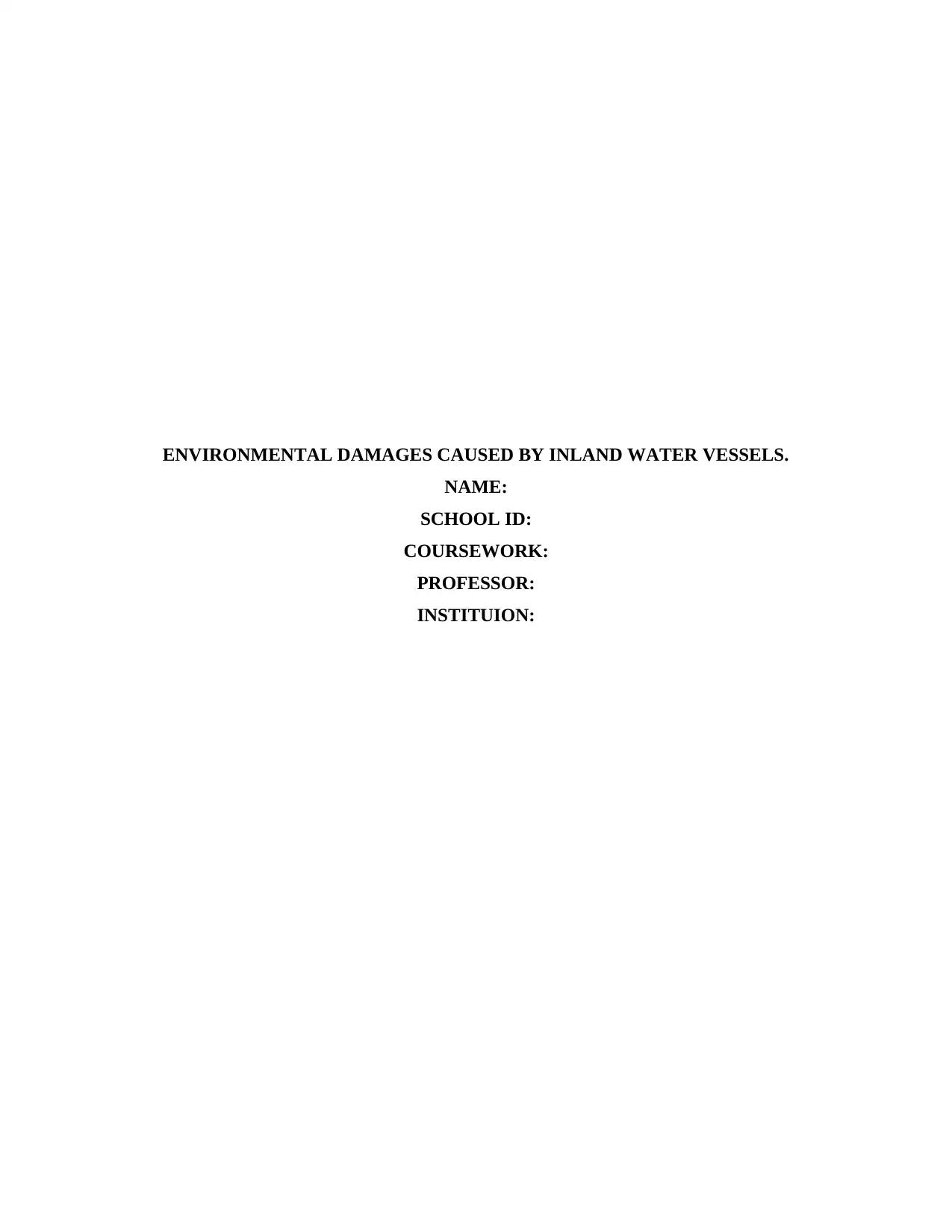
ENVIRONMENTAL DAMAGES CAUSED BY INLAND WATER VESSELS.
NAME:
SCHOOL ID:
COURSEWORK:
PROFESSOR:
INSTITUION:
NAME:
SCHOOL ID:
COURSEWORK:
PROFESSOR:
INSTITUION:
Paraphrase This Document
Need a fresh take? Get an instant paraphrase of this document with our AI Paraphraser
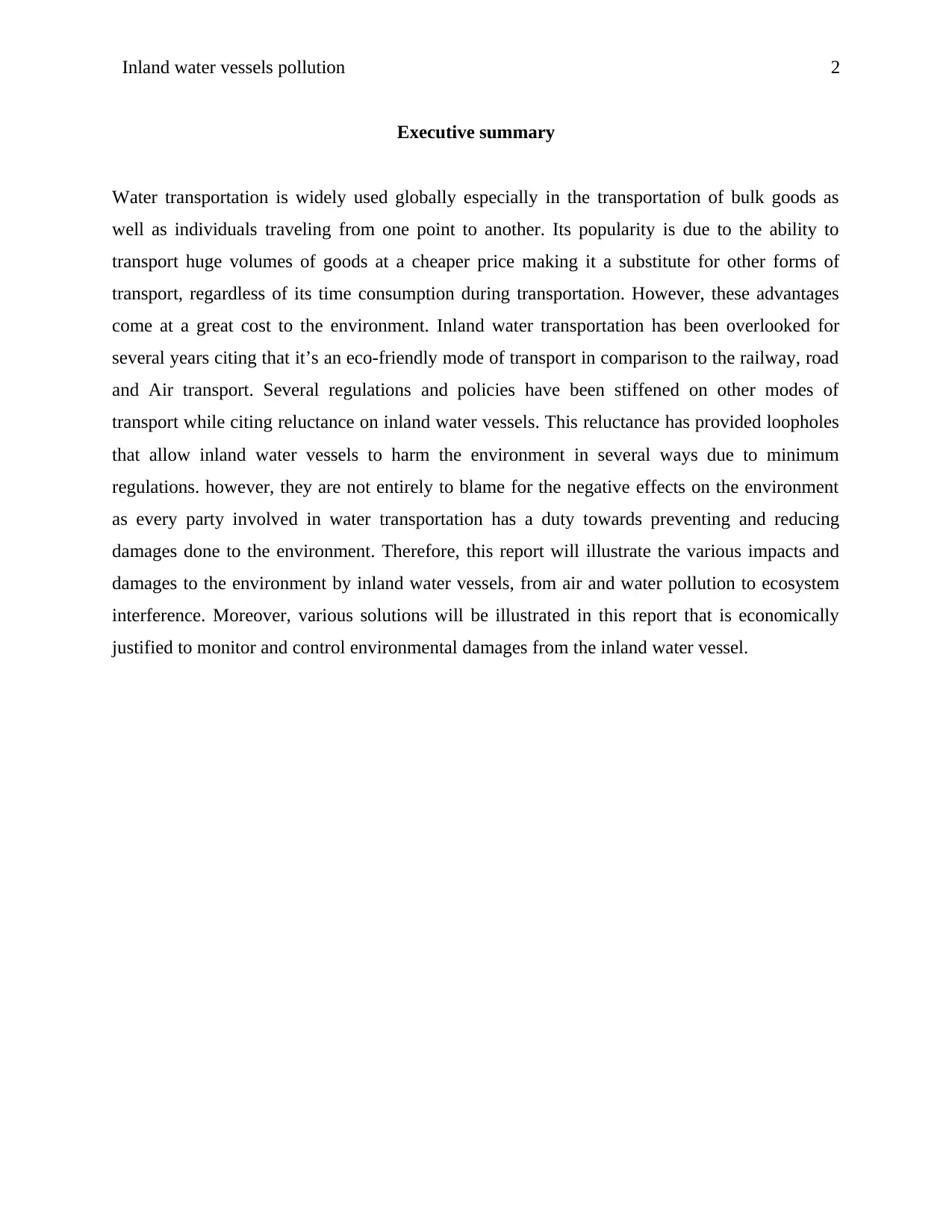
Inland water vessels pollution 2
Executive summary
Water transportation is widely used globally especially in the transportation of bulk goods as
well as individuals traveling from one point to another. Its popularity is due to the ability to
transport huge volumes of goods at a cheaper price making it a substitute for other forms of
transport, regardless of its time consumption during transportation. However, these advantages
come at a great cost to the environment. Inland water transportation has been overlooked for
several years citing that it’s an eco-friendly mode of transport in comparison to the railway, road
and Air transport. Several regulations and policies have been stiffened on other modes of
transport while citing reluctance on inland water vessels. This reluctance has provided loopholes
that allow inland water vessels to harm the environment in several ways due to minimum
regulations. however, they are not entirely to blame for the negative effects on the environment
as every party involved in water transportation has a duty towards preventing and reducing
damages done to the environment. Therefore, this report will illustrate the various impacts and
damages to the environment by inland water vessels, from air and water pollution to ecosystem
interference. Moreover, various solutions will be illustrated in this report that is economically
justified to monitor and control environmental damages from the inland water vessel.
Executive summary
Water transportation is widely used globally especially in the transportation of bulk goods as
well as individuals traveling from one point to another. Its popularity is due to the ability to
transport huge volumes of goods at a cheaper price making it a substitute for other forms of
transport, regardless of its time consumption during transportation. However, these advantages
come at a great cost to the environment. Inland water transportation has been overlooked for
several years citing that it’s an eco-friendly mode of transport in comparison to the railway, road
and Air transport. Several regulations and policies have been stiffened on other modes of
transport while citing reluctance on inland water vessels. This reluctance has provided loopholes
that allow inland water vessels to harm the environment in several ways due to minimum
regulations. however, they are not entirely to blame for the negative effects on the environment
as every party involved in water transportation has a duty towards preventing and reducing
damages done to the environment. Therefore, this report will illustrate the various impacts and
damages to the environment by inland water vessels, from air and water pollution to ecosystem
interference. Moreover, various solutions will be illustrated in this report that is economically
justified to monitor and control environmental damages from the inland water vessel.
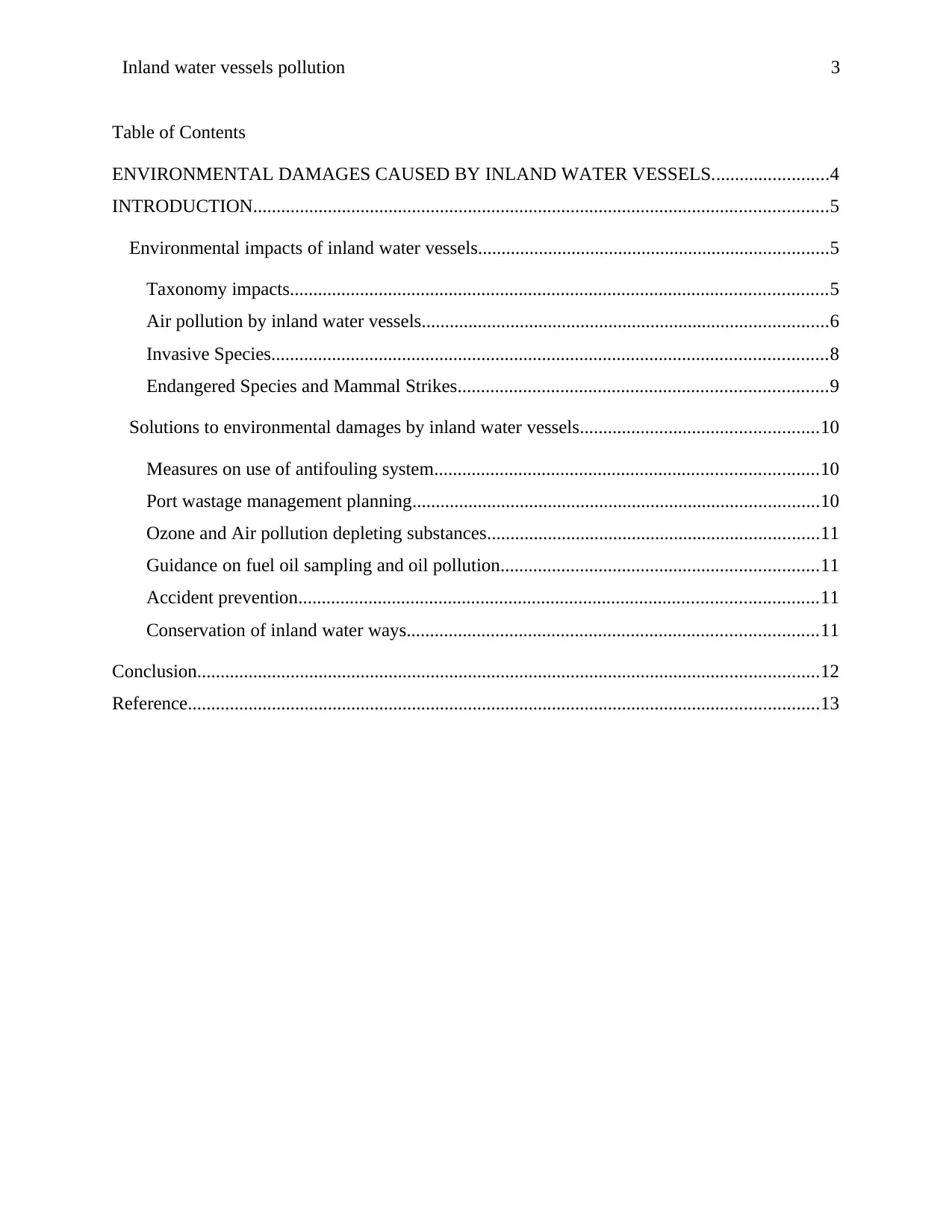
Inland water vessels pollution 3
Table of Contents
ENVIRONMENTAL DAMAGES CAUSED BY INLAND WATER VESSELS.........................4
INTRODUCTION...........................................................................................................................5
Environmental impacts of inland water vessels...........................................................................5
Taxonomy impacts...................................................................................................................5
Air pollution by inland water vessels.......................................................................................6
Invasive Species.......................................................................................................................8
Endangered Species and Mammal Strikes...............................................................................9
Solutions to environmental damages by inland water vessels...................................................10
Measures on use of antifouling system..................................................................................10
Port wastage management planning.......................................................................................10
Ozone and Air pollution depleting substances.......................................................................11
Guidance on fuel oil sampling and oil pollution....................................................................11
Accident prevention...............................................................................................................11
Conservation of inland water ways........................................................................................11
Conclusion.....................................................................................................................................12
Reference.......................................................................................................................................13
Table of Contents
ENVIRONMENTAL DAMAGES CAUSED BY INLAND WATER VESSELS.........................4
INTRODUCTION...........................................................................................................................5
Environmental impacts of inland water vessels...........................................................................5
Taxonomy impacts...................................................................................................................5
Air pollution by inland water vessels.......................................................................................6
Invasive Species.......................................................................................................................8
Endangered Species and Mammal Strikes...............................................................................9
Solutions to environmental damages by inland water vessels...................................................10
Measures on use of antifouling system..................................................................................10
Port wastage management planning.......................................................................................10
Ozone and Air pollution depleting substances.......................................................................11
Guidance on fuel oil sampling and oil pollution....................................................................11
Accident prevention...............................................................................................................11
Conservation of inland water ways........................................................................................11
Conclusion.....................................................................................................................................12
Reference.......................................................................................................................................13
⊘ This is a preview!⊘
Do you want full access?
Subscribe today to unlock all pages.

Trusted by 1+ million students worldwide
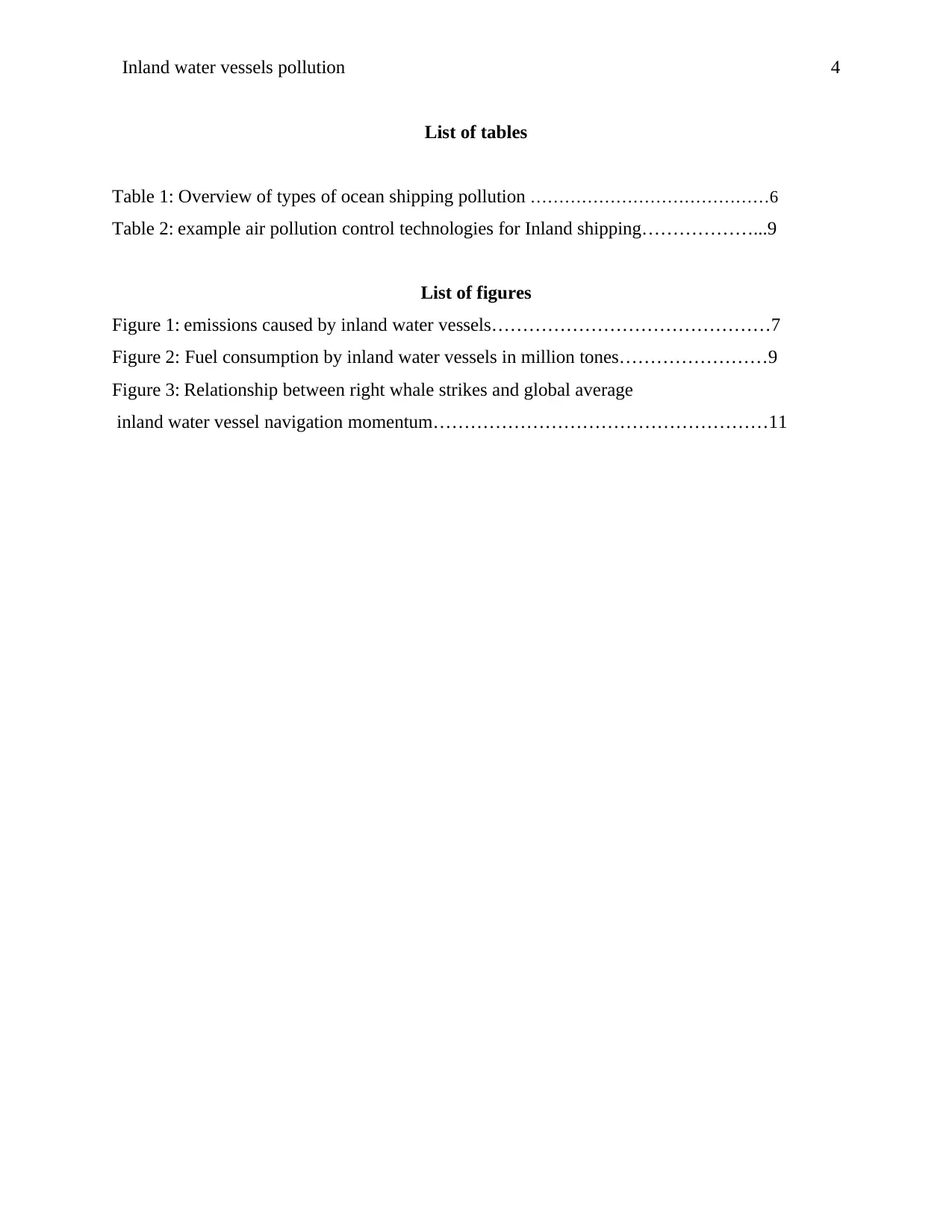
Inland water vessels pollution 4
List of tables
Table 1: Overview of types of ocean shipping pollution ……………………………………6
Table 2: example air pollution control technologies for Inland shipping………………...9
List of figures
Figure 1: emissions caused by inland water vessels………………………………………7
Figure 2: Fuel consumption by inland water vessels in million tones……………………9
Figure 3: Relationship between right whale strikes and global average
inland water vessel navigation momentum………………………………………………11
List of tables
Table 1: Overview of types of ocean shipping pollution ……………………………………6
Table 2: example air pollution control technologies for Inland shipping………………...9
List of figures
Figure 1: emissions caused by inland water vessels………………………………………7
Figure 2: Fuel consumption by inland water vessels in million tones……………………9
Figure 3: Relationship between right whale strikes and global average
inland water vessel navigation momentum………………………………………………11
Paraphrase This Document
Need a fresh take? Get an instant paraphrase of this document with our AI Paraphraser
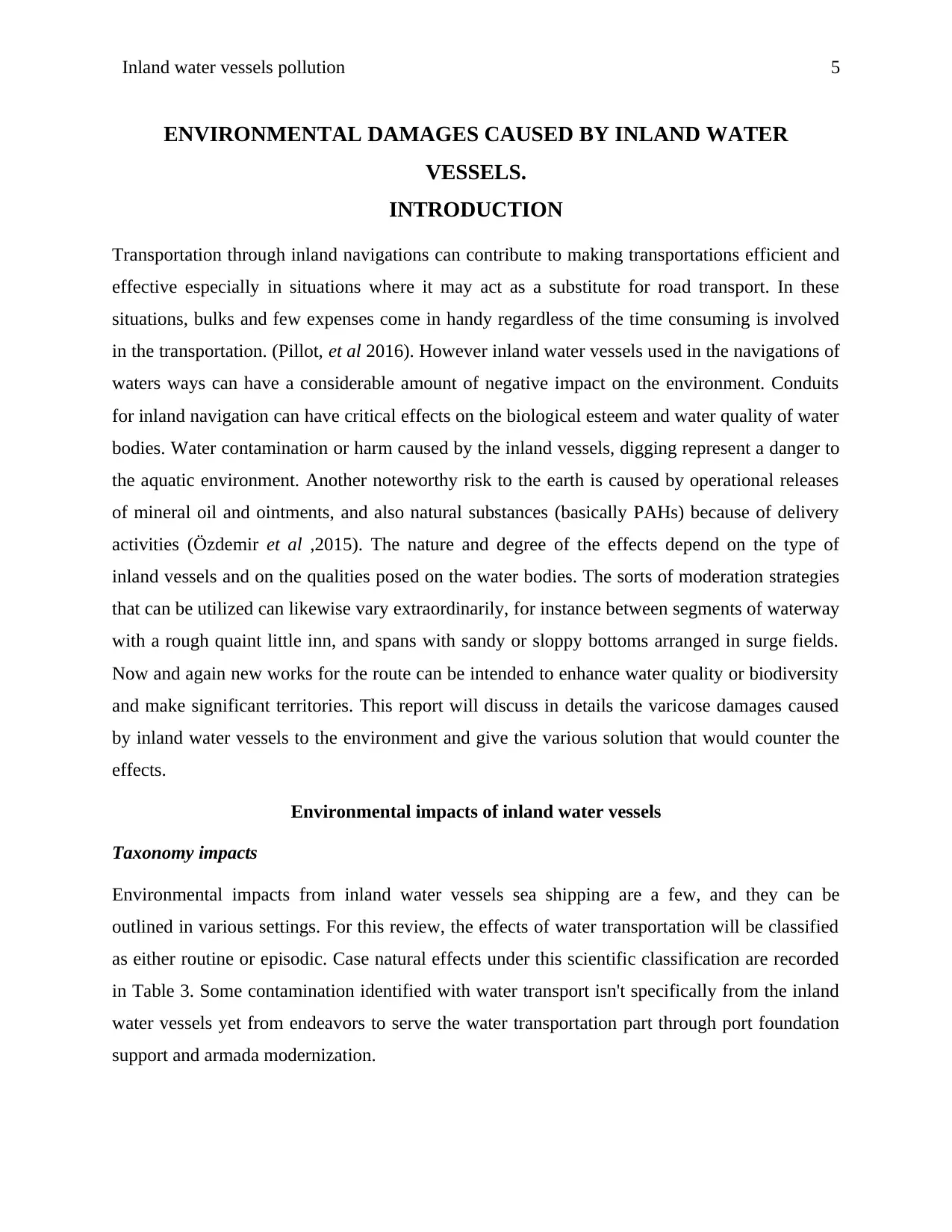
Inland water vessels pollution 5
ENVIRONMENTAL DAMAGES CAUSED BY INLAND WATER
VESSELS.
INTRODUCTION
Transportation through inland navigations can contribute to making transportations efficient and
effective especially in situations where it may act as a substitute for road transport. In these
situations, bulks and few expenses come in handy regardless of the time consuming is involved
in the transportation. (Pillot, et al 2016). However inland water vessels used in the navigations of
waters ways can have a considerable amount of negative impact on the environment. Conduits
for inland navigation can have critical effects on the biological esteem and water quality of water
bodies. Water contamination or harm caused by the inland vessels, digging represent a danger to
the aquatic environment. Another noteworthy risk to the earth is caused by operational releases
of mineral oil and ointments, and also natural substances (basically PAHs) because of delivery
activities (Özdemir et al ,2015). The nature and degree of the effects depend on the type of
inland vessels and on the qualities posed on the water bodies. The sorts of moderation strategies
that can be utilized can likewise vary extraordinarily, for instance between segments of waterway
with a rough quaint little inn, and spans with sandy or sloppy bottoms arranged in surge fields.
Now and again new works for the route can be intended to enhance water quality or biodiversity
and make significant territories. This report will discuss in details the varicose damages caused
by inland water vessels to the environment and give the various solution that would counter the
effects.
Environmental impacts of inland water vessels
Taxonomy impacts
Environmental impacts from inland water vessels sea shipping are a few, and they can be
outlined in various settings. For this review, the effects of water transportation will be classified
as either routine or episodic. Case natural effects under this scientific classification are recorded
in Table 3. Some contamination identified with water transport isn't specifically from the inland
water vessels yet from endeavors to serve the water transportation part through port foundation
support and armada modernization.
ENVIRONMENTAL DAMAGES CAUSED BY INLAND WATER
VESSELS.
INTRODUCTION
Transportation through inland navigations can contribute to making transportations efficient and
effective especially in situations where it may act as a substitute for road transport. In these
situations, bulks and few expenses come in handy regardless of the time consuming is involved
in the transportation. (Pillot, et al 2016). However inland water vessels used in the navigations of
waters ways can have a considerable amount of negative impact on the environment. Conduits
for inland navigation can have critical effects on the biological esteem and water quality of water
bodies. Water contamination or harm caused by the inland vessels, digging represent a danger to
the aquatic environment. Another noteworthy risk to the earth is caused by operational releases
of mineral oil and ointments, and also natural substances (basically PAHs) because of delivery
activities (Özdemir et al ,2015). The nature and degree of the effects depend on the type of
inland vessels and on the qualities posed on the water bodies. The sorts of moderation strategies
that can be utilized can likewise vary extraordinarily, for instance between segments of waterway
with a rough quaint little inn, and spans with sandy or sloppy bottoms arranged in surge fields.
Now and again new works for the route can be intended to enhance water quality or biodiversity
and make significant territories. This report will discuss in details the varicose damages caused
by inland water vessels to the environment and give the various solution that would counter the
effects.
Environmental impacts of inland water vessels
Taxonomy impacts
Environmental impacts from inland water vessels sea shipping are a few, and they can be
outlined in various settings. For this review, the effects of water transportation will be classified
as either routine or episodic. Case natural effects under this scientific classification are recorded
in Table 3. Some contamination identified with water transport isn't specifically from the inland
water vessels yet from endeavors to serve the water transportation part through port foundation
support and armada modernization.
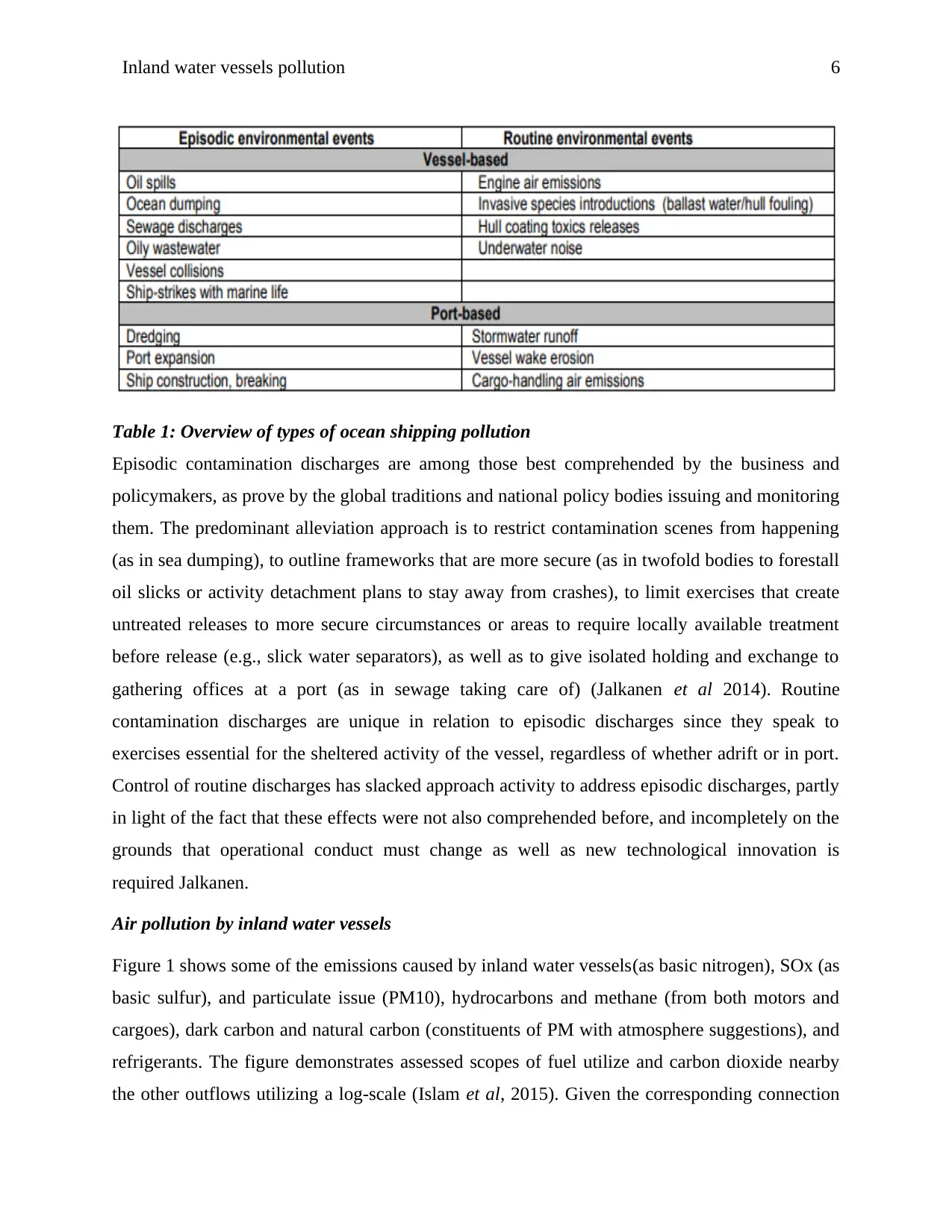
Inland water vessels pollution 6
Table 1: Overview of types of ocean shipping pollution
Episodic contamination discharges are among those best comprehended by the business and
policymakers, as prove by the global traditions and national policy bodies issuing and monitoring
them. The predominant alleviation approach is to restrict contamination scenes from happening
(as in sea dumping), to outline frameworks that are more secure (as in twofold bodies to forestall
oil slicks or activity detachment plans to stay away from crashes), to limit exercises that create
untreated releases to more secure circumstances or areas to require locally available treatment
before release (e.g., slick water separators), as well as to give isolated holding and exchange to
gathering offices at a port (as in sewage taking care of) (Jalkanen et al 2014). Routine
contamination discharges are unique in relation to episodic discharges since they speak to
exercises essential for the sheltered activity of the vessel, regardless of whether adrift or in port.
Control of routine discharges has slacked approach activity to address episodic discharges, partly
in light of the fact that these effects were not also comprehended before, and incompletely on the
grounds that operational conduct must change as well as new technological innovation is
required Jalkanen.
Air pollution by inland water vessels
Figure 1 shows some of the emissions caused by inland water vessels(as basic nitrogen), SOx (as
basic sulfur), and particulate issue (PM10), hydrocarbons and methane (from both motors and
cargoes), dark carbon and natural carbon (constituents of PM with atmosphere suggestions), and
refrigerants. The figure demonstrates assessed scopes of fuel utilize and carbon dioxide nearby
the other outflows utilizing a log-scale (Islam et al, 2015). Given the corresponding connection
Table 1: Overview of types of ocean shipping pollution
Episodic contamination discharges are among those best comprehended by the business and
policymakers, as prove by the global traditions and national policy bodies issuing and monitoring
them. The predominant alleviation approach is to restrict contamination scenes from happening
(as in sea dumping), to outline frameworks that are more secure (as in twofold bodies to forestall
oil slicks or activity detachment plans to stay away from crashes), to limit exercises that create
untreated releases to more secure circumstances or areas to require locally available treatment
before release (e.g., slick water separators), as well as to give isolated holding and exchange to
gathering offices at a port (as in sewage taking care of) (Jalkanen et al 2014). Routine
contamination discharges are unique in relation to episodic discharges since they speak to
exercises essential for the sheltered activity of the vessel, regardless of whether adrift or in port.
Control of routine discharges has slacked approach activity to address episodic discharges, partly
in light of the fact that these effects were not also comprehended before, and incompletely on the
grounds that operational conduct must change as well as new technological innovation is
required Jalkanen.
Air pollution by inland water vessels
Figure 1 shows some of the emissions caused by inland water vessels(as basic nitrogen), SOx (as
basic sulfur), and particulate issue (PM10), hydrocarbons and methane (from both motors and
cargoes), dark carbon and natural carbon (constituents of PM with atmosphere suggestions), and
refrigerants. The figure demonstrates assessed scopes of fuel utilize and carbon dioxide nearby
the other outflows utilizing a log-scale (Islam et al, 2015). Given the corresponding connection
⊘ This is a preview!⊘
Do you want full access?
Subscribe today to unlock all pages.

Trusted by 1+ million students worldwide
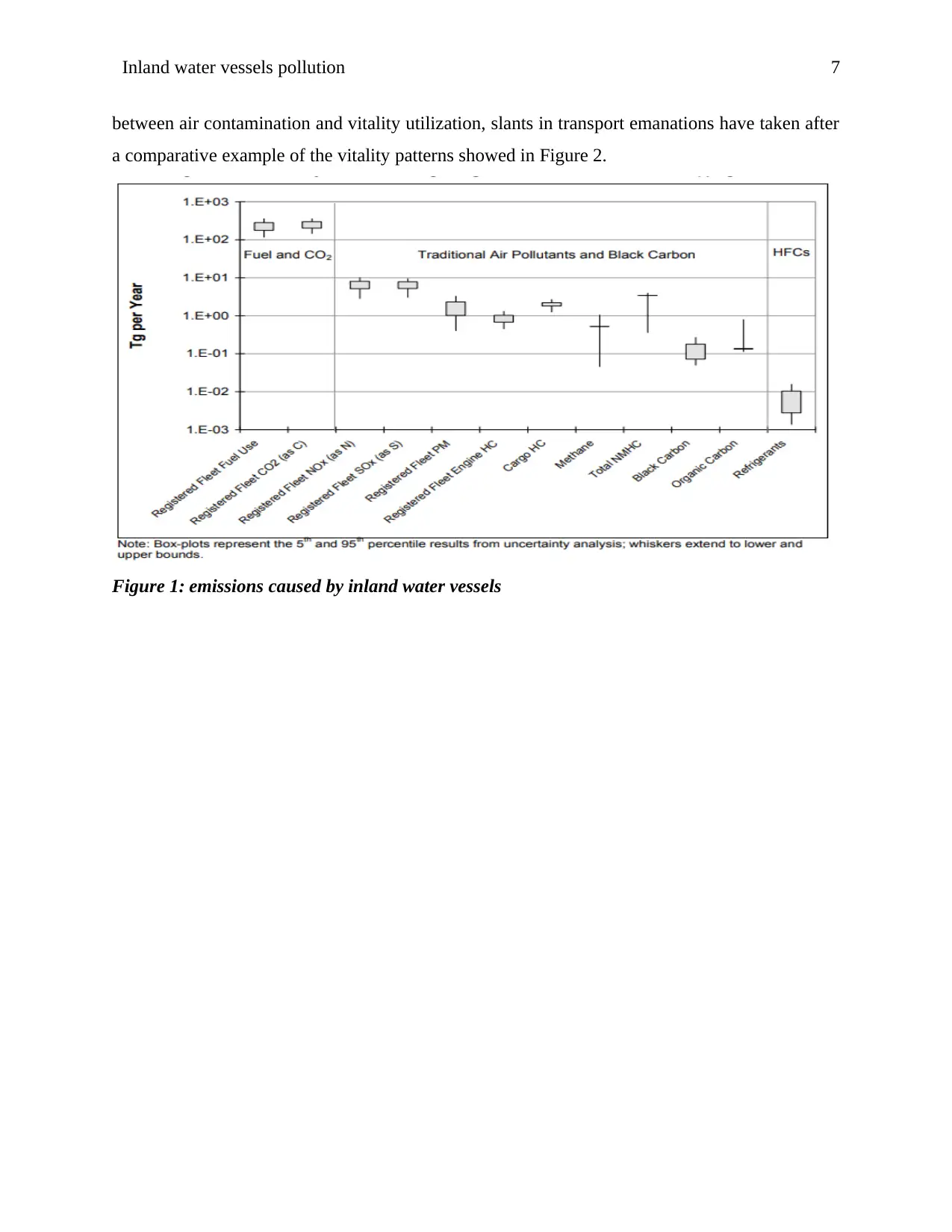
Inland water vessels pollution 7
between air contamination and vitality utilization, slants in transport emanations have taken after
a comparative example of the vitality patterns showed in Figure 2.
Figure 1: emissions caused by inland water vessels
between air contamination and vitality utilization, slants in transport emanations have taken after
a comparative example of the vitality patterns showed in Figure 2.
Figure 1: emissions caused by inland water vessels
Paraphrase This Document
Need a fresh take? Get an instant paraphrase of this document with our AI Paraphraser
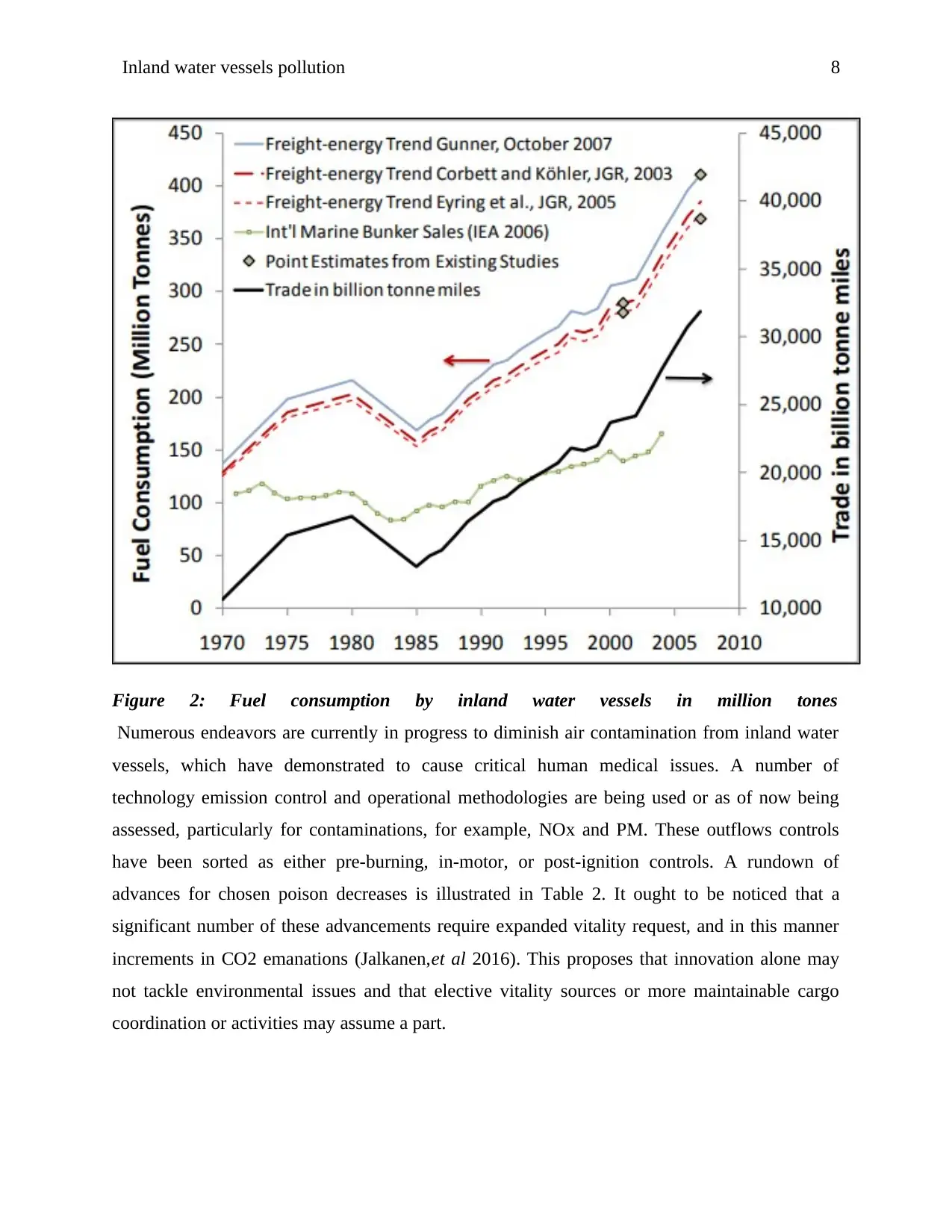
Inland water vessels pollution 8
Figure 2: Fuel consumption by inland water vessels in million tones
Numerous endeavors are currently in progress to diminish air contamination from inland water
vessels, which have demonstrated to cause critical human medical issues. A number of
technology emission control and operational methodologies are being used or as of now being
assessed, particularly for contaminations, for example, NOx and PM. These outflows controls
have been sorted as either pre-burning, in-motor, or post-ignition controls. A rundown of
advances for chosen poison decreases is illustrated in Table 2. It ought to be noticed that a
significant number of these advancements require expanded vitality request, and in this manner
increments in CO2 emanations (Jalkanen,et al 2016). This proposes that innovation alone may
not tackle environmental issues and that elective vitality sources or more maintainable cargo
coordination or activities may assume a part.
Figure 2: Fuel consumption by inland water vessels in million tones
Numerous endeavors are currently in progress to diminish air contamination from inland water
vessels, which have demonstrated to cause critical human medical issues. A number of
technology emission control and operational methodologies are being used or as of now being
assessed, particularly for contaminations, for example, NOx and PM. These outflows controls
have been sorted as either pre-burning, in-motor, or post-ignition controls. A rundown of
advances for chosen poison decreases is illustrated in Table 2. It ought to be noticed that a
significant number of these advancements require expanded vitality request, and in this manner
increments in CO2 emanations (Jalkanen,et al 2016). This proposes that innovation alone may
not tackle environmental issues and that elective vitality sources or more maintainable cargo
coordination or activities may assume a part.
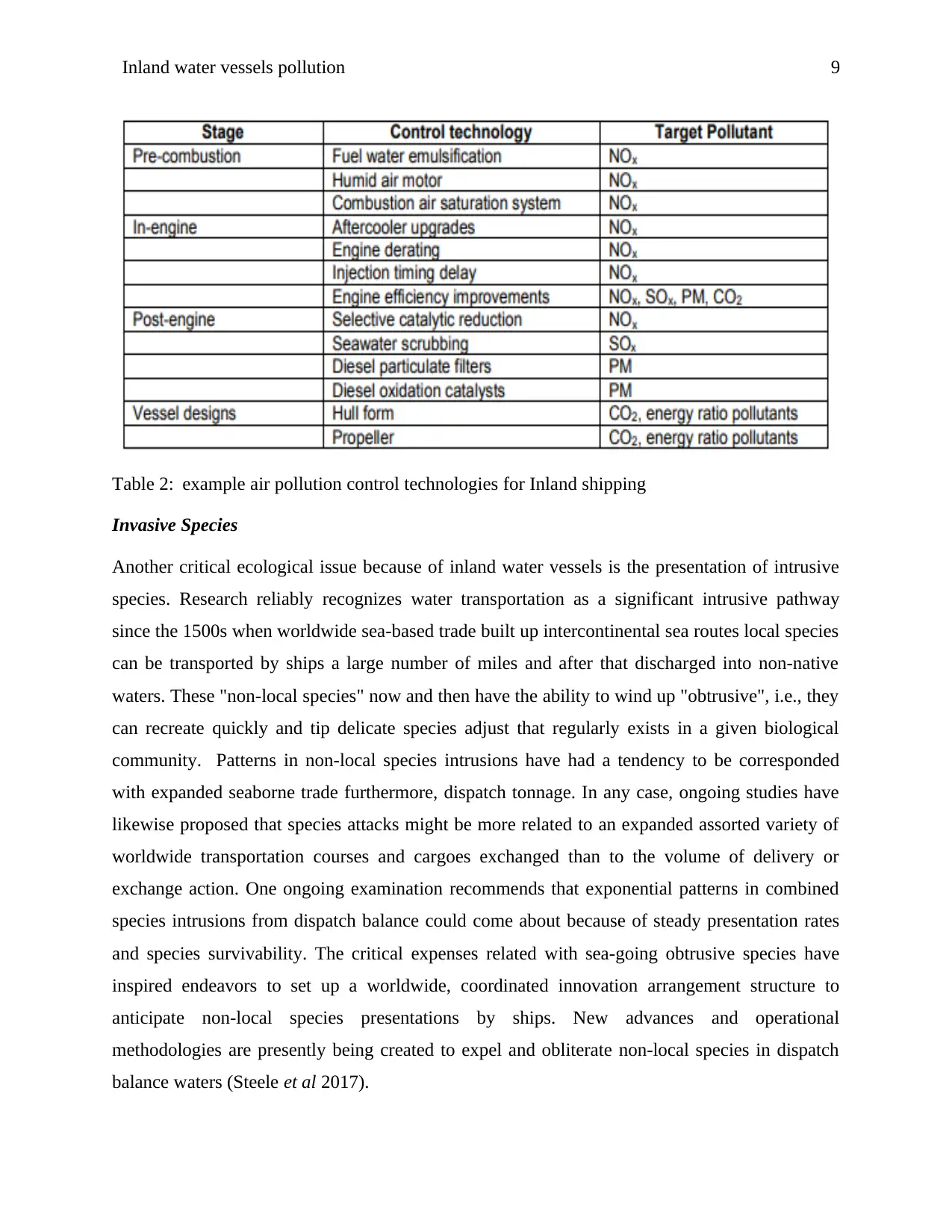
Inland water vessels pollution 9
Table 2: example air pollution control technologies for Inland shipping
Invasive Species
Another critical ecological issue because of inland water vessels is the presentation of intrusive
species. Research reliably recognizes water transportation as a significant intrusive pathway
since the 1500s when worldwide sea-based trade built up intercontinental sea routes local species
can be transported by ships a large number of miles and after that discharged into non-native
waters. These "non-local species" now and then have the ability to wind up "obtrusive", i.e., they
can recreate quickly and tip delicate species adjust that regularly exists in a given biological
community. Patterns in non-local species intrusions have had a tendency to be corresponded
with expanded seaborne trade furthermore, dispatch tonnage. In any case, ongoing studies have
likewise proposed that species attacks might be more related to an expanded assorted variety of
worldwide transportation courses and cargoes exchanged than to the volume of delivery or
exchange action. One ongoing examination recommends that exponential patterns in combined
species intrusions from dispatch balance could come about because of steady presentation rates
and species survivability. The critical expenses related with sea-going obtrusive species have
inspired endeavors to set up a worldwide, coordinated innovation arrangement structure to
anticipate non-local species presentations by ships. New advances and operational
methodologies are presently being created to expel and obliterate non-local species in dispatch
balance waters (Steele et al 2017).
Table 2: example air pollution control technologies for Inland shipping
Invasive Species
Another critical ecological issue because of inland water vessels is the presentation of intrusive
species. Research reliably recognizes water transportation as a significant intrusive pathway
since the 1500s when worldwide sea-based trade built up intercontinental sea routes local species
can be transported by ships a large number of miles and after that discharged into non-native
waters. These "non-local species" now and then have the ability to wind up "obtrusive", i.e., they
can recreate quickly and tip delicate species adjust that regularly exists in a given biological
community. Patterns in non-local species intrusions have had a tendency to be corresponded
with expanded seaborne trade furthermore, dispatch tonnage. In any case, ongoing studies have
likewise proposed that species attacks might be more related to an expanded assorted variety of
worldwide transportation courses and cargoes exchanged than to the volume of delivery or
exchange action. One ongoing examination recommends that exponential patterns in combined
species intrusions from dispatch balance could come about because of steady presentation rates
and species survivability. The critical expenses related with sea-going obtrusive species have
inspired endeavors to set up a worldwide, coordinated innovation arrangement structure to
anticipate non-local species presentations by ships. New advances and operational
methodologies are presently being created to expel and obliterate non-local species in dispatch
balance waters (Steele et al 2017).
⊘ This is a preview!⊘
Do you want full access?
Subscribe today to unlock all pages.

Trusted by 1+ million students worldwide
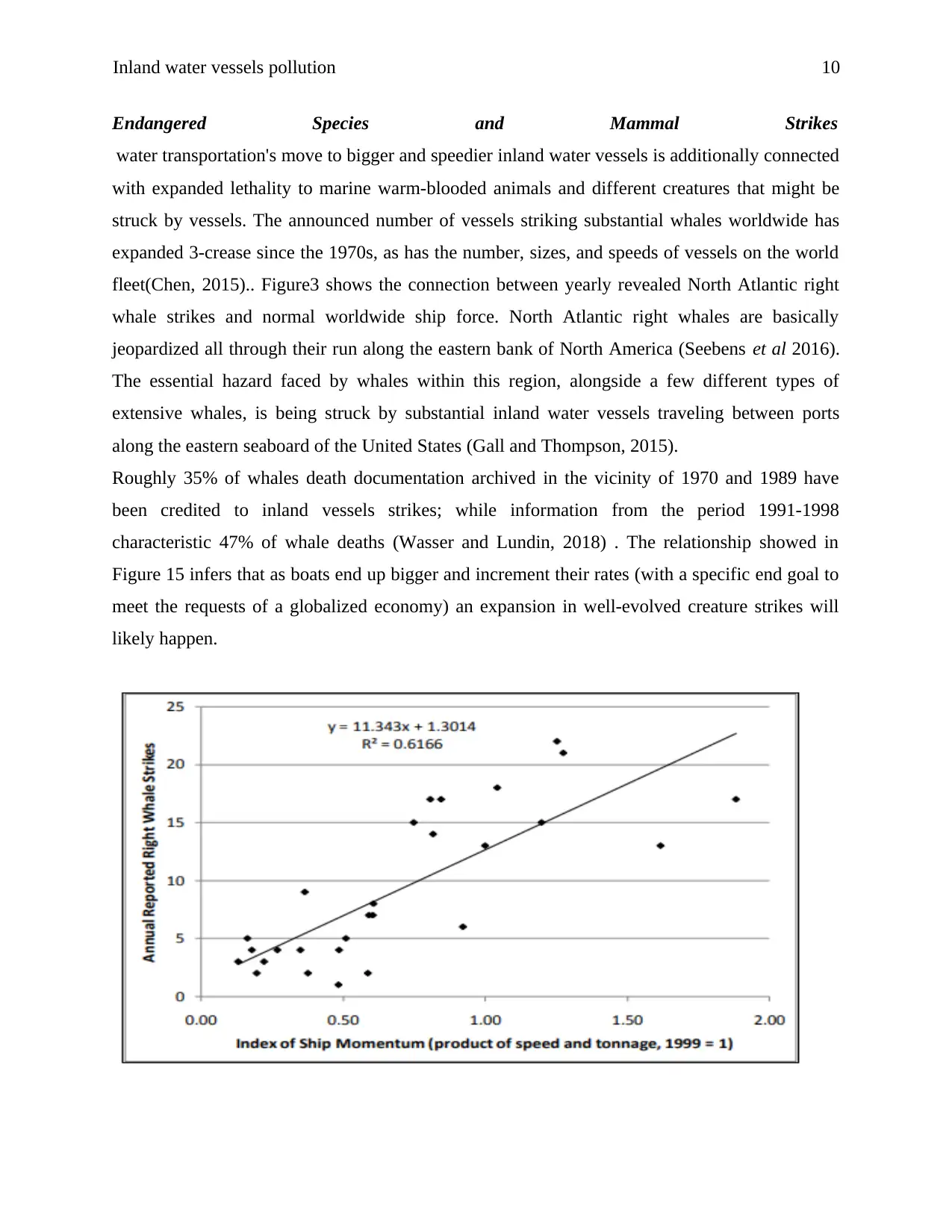
Inland water vessels pollution 10
Endangered Species and Mammal Strikes
water transportation's move to bigger and speedier inland water vessels is additionally connected
with expanded lethality to marine warm-blooded animals and different creatures that might be
struck by vessels. The announced number of vessels striking substantial whales worldwide has
expanded 3-crease since the 1970s, as has the number, sizes, and speeds of vessels on the world
fleet(Chen, 2015).. Figure3 shows the connection between yearly revealed North Atlantic right
whale strikes and normal worldwide ship force. North Atlantic right whales are basically
jeopardized all through their run along the eastern bank of North America (Seebens et al 2016).
The essential hazard faced by whales within this region, alongside a few different types of
extensive whales, is being struck by substantial inland water vessels traveling between ports
along the eastern seaboard of the United States (Gall and Thompson, 2015).
Roughly 35% of whales death documentation archived in the vicinity of 1970 and 1989 have
been credited to inland vessels strikes; while information from the period 1991-1998
characteristic 47% of whale deaths (Wasser and Lundin, 2018) . The relationship showed in
Figure 15 infers that as boats end up bigger and increment their rates (with a specific end goal to
meet the requests of a globalized economy) an expansion in well-evolved creature strikes will
likely happen.
Endangered Species and Mammal Strikes
water transportation's move to bigger and speedier inland water vessels is additionally connected
with expanded lethality to marine warm-blooded animals and different creatures that might be
struck by vessels. The announced number of vessels striking substantial whales worldwide has
expanded 3-crease since the 1970s, as has the number, sizes, and speeds of vessels on the world
fleet(Chen, 2015).. Figure3 shows the connection between yearly revealed North Atlantic right
whale strikes and normal worldwide ship force. North Atlantic right whales are basically
jeopardized all through their run along the eastern bank of North America (Seebens et al 2016).
The essential hazard faced by whales within this region, alongside a few different types of
extensive whales, is being struck by substantial inland water vessels traveling between ports
along the eastern seaboard of the United States (Gall and Thompson, 2015).
Roughly 35% of whales death documentation archived in the vicinity of 1970 and 1989 have
been credited to inland vessels strikes; while information from the period 1991-1998
characteristic 47% of whale deaths (Wasser and Lundin, 2018) . The relationship showed in
Figure 15 infers that as boats end up bigger and increment their rates (with a specific end goal to
meet the requests of a globalized economy) an expansion in well-evolved creature strikes will
likely happen.
Paraphrase This Document
Need a fresh take? Get an instant paraphrase of this document with our AI Paraphraser
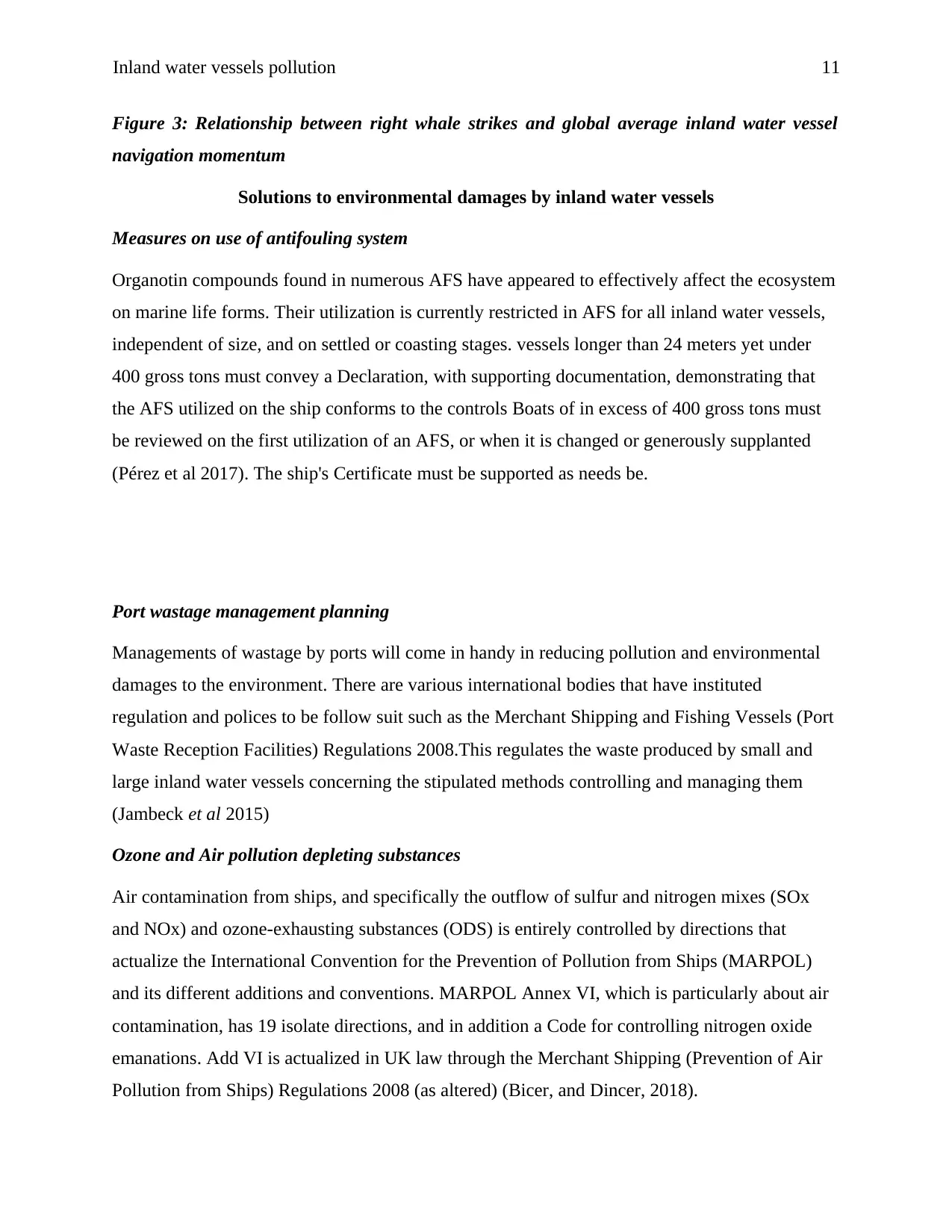
Inland water vessels pollution 11
Figure 3: Relationship between right whale strikes and global average inland water vessel
navigation momentum
Solutions to environmental damages by inland water vessels
Measures on use of antifouling system
Organotin compounds found in numerous AFS have appeared to effectively affect the ecosystem
on marine life forms. Their utilization is currently restricted in AFS for all inland water vessels,
independent of size, and on settled or coasting stages. vessels longer than 24 meters yet under
400 gross tons must convey a Declaration, with supporting documentation, demonstrating that
the AFS utilized on the ship conforms to the controls Boats of in excess of 400 gross tons must
be reviewed on the first utilization of an AFS, or when it is changed or generously supplanted
(Pérez et al 2017). The ship's Certificate must be supported as needs be.
Port wastage management planning
Managements of wastage by ports will come in handy in reducing pollution and environmental
damages to the environment. There are various international bodies that have instituted
regulation and polices to be follow suit such as the Merchant Shipping and Fishing Vessels (Port
Waste Reception Facilities) Regulations 2008.This regulates the waste produced by small and
large inland water vessels concerning the stipulated methods controlling and managing them
(Jambeck et al 2015)
Ozone and Air pollution depleting substances
Air contamination from ships, and specifically the outflow of sulfur and nitrogen mixes (SOx
and NOx) and ozone-exhausting substances (ODS) is entirely controlled by directions that
actualize the International Convention for the Prevention of Pollution from Ships (MARPOL)
and its different additions and conventions. MARPOL Annex VI, which is particularly about air
contamination, has 19 isolate directions, and in addition a Code for controlling nitrogen oxide
emanations. Add VI is actualized in UK law through the Merchant Shipping (Prevention of Air
Pollution from Ships) Regulations 2008 (as altered) (Bicer, and Dincer, 2018).
Figure 3: Relationship between right whale strikes and global average inland water vessel
navigation momentum
Solutions to environmental damages by inland water vessels
Measures on use of antifouling system
Organotin compounds found in numerous AFS have appeared to effectively affect the ecosystem
on marine life forms. Their utilization is currently restricted in AFS for all inland water vessels,
independent of size, and on settled or coasting stages. vessels longer than 24 meters yet under
400 gross tons must convey a Declaration, with supporting documentation, demonstrating that
the AFS utilized on the ship conforms to the controls Boats of in excess of 400 gross tons must
be reviewed on the first utilization of an AFS, or when it is changed or generously supplanted
(Pérez et al 2017). The ship's Certificate must be supported as needs be.
Port wastage management planning
Managements of wastage by ports will come in handy in reducing pollution and environmental
damages to the environment. There are various international bodies that have instituted
regulation and polices to be follow suit such as the Merchant Shipping and Fishing Vessels (Port
Waste Reception Facilities) Regulations 2008.This regulates the waste produced by small and
large inland water vessels concerning the stipulated methods controlling and managing them
(Jambeck et al 2015)
Ozone and Air pollution depleting substances
Air contamination from ships, and specifically the outflow of sulfur and nitrogen mixes (SOx
and NOx) and ozone-exhausting substances (ODS) is entirely controlled by directions that
actualize the International Convention for the Prevention of Pollution from Ships (MARPOL)
and its different additions and conventions. MARPOL Annex VI, which is particularly about air
contamination, has 19 isolate directions, and in addition a Code for controlling nitrogen oxide
emanations. Add VI is actualized in UK law through the Merchant Shipping (Prevention of Air
Pollution from Ships) Regulations 2008 (as altered) (Bicer, and Dincer, 2018).
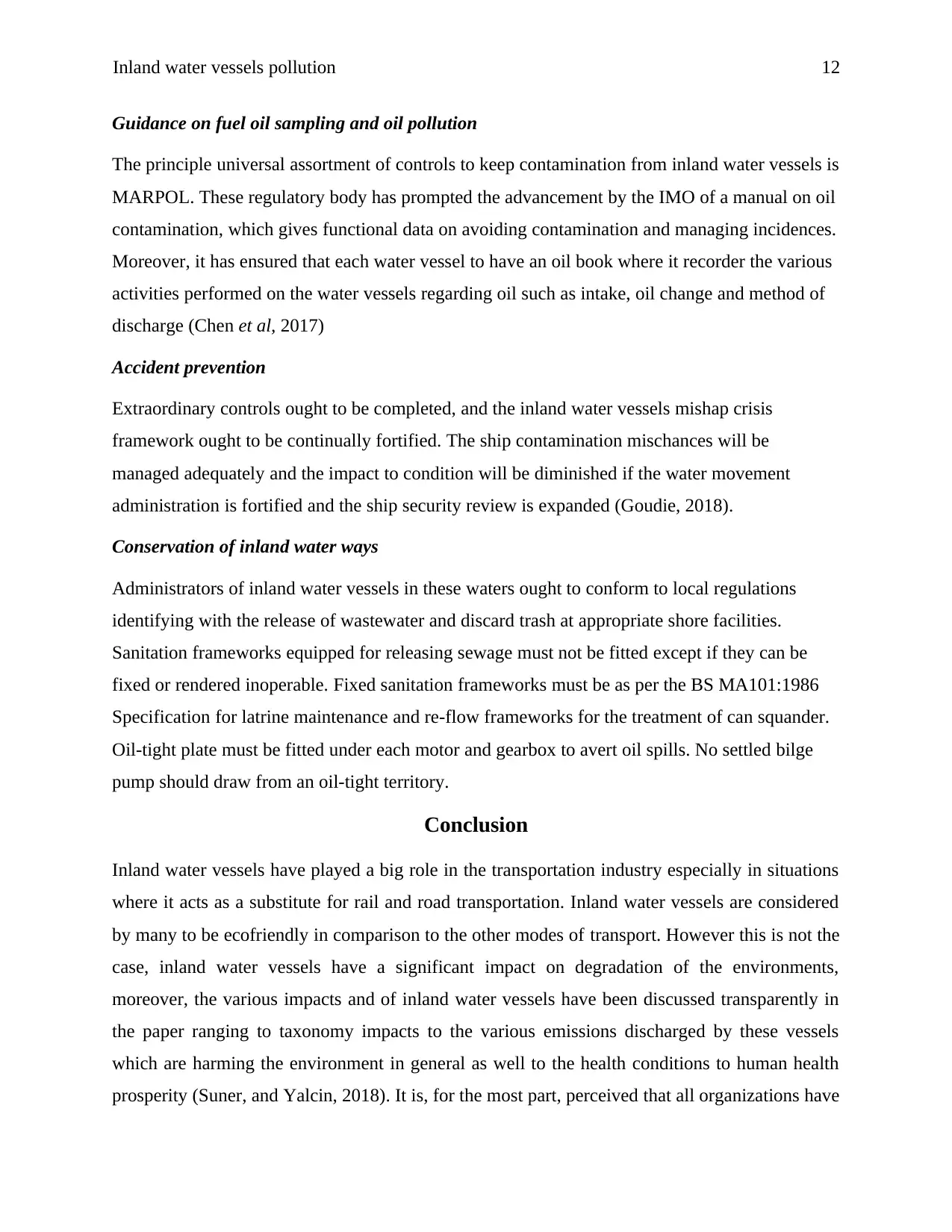
Inland water vessels pollution 12
Guidance on fuel oil sampling and oil pollution
The principle universal assortment of controls to keep contamination from inland water vessels is
MARPOL. These regulatory body has prompted the advancement by the IMO of a manual on oil
contamination, which gives functional data on avoiding contamination and managing incidences.
Moreover, it has ensured that each water vessel to have an oil book where it recorder the various
activities performed on the water vessels regarding oil such as intake, oil change and method of
discharge (Chen et al, 2017)
Accident prevention
Extraordinary controls ought to be completed, and the inland water vessels mishap crisis
framework ought to be continually fortified. The ship contamination mischances will be
managed adequately and the impact to condition will be diminished if the water movement
administration is fortified and the ship security review is expanded (Goudie, 2018).
Conservation of inland water ways
Administrators of inland water vessels in these waters ought to conform to local regulations
identifying with the release of wastewater and discard trash at appropriate shore facilities.
Sanitation frameworks equipped for releasing sewage must not be fitted except if they can be
fixed or rendered inoperable. Fixed sanitation frameworks must be as per the BS MA101:1986
Specification for latrine maintenance and re-flow frameworks for the treatment of can squander.
Oil-tight plate must be fitted under each motor and gearbox to avert oil spills. No settled bilge
pump should draw from an oil-tight territory.
Conclusion
Inland water vessels have played a big role in the transportation industry especially in situations
where it acts as a substitute for rail and road transportation. Inland water vessels are considered
by many to be ecofriendly in comparison to the other modes of transport. However this is not the
case, inland water vessels have a significant impact on degradation of the environments,
moreover, the various impacts and of inland water vessels have been discussed transparently in
the paper ranging to taxonomy impacts to the various emissions discharged by these vessels
which are harming the environment in general as well to the health conditions to human health
prosperity (Suner, and Yalcin, 2018). It is, for the most part, perceived that all organizations have
Guidance on fuel oil sampling and oil pollution
The principle universal assortment of controls to keep contamination from inland water vessels is
MARPOL. These regulatory body has prompted the advancement by the IMO of a manual on oil
contamination, which gives functional data on avoiding contamination and managing incidences.
Moreover, it has ensured that each water vessel to have an oil book where it recorder the various
activities performed on the water vessels regarding oil such as intake, oil change and method of
discharge (Chen et al, 2017)
Accident prevention
Extraordinary controls ought to be completed, and the inland water vessels mishap crisis
framework ought to be continually fortified. The ship contamination mischances will be
managed adequately and the impact to condition will be diminished if the water movement
administration is fortified and the ship security review is expanded (Goudie, 2018).
Conservation of inland water ways
Administrators of inland water vessels in these waters ought to conform to local regulations
identifying with the release of wastewater and discard trash at appropriate shore facilities.
Sanitation frameworks equipped for releasing sewage must not be fitted except if they can be
fixed or rendered inoperable. Fixed sanitation frameworks must be as per the BS MA101:1986
Specification for latrine maintenance and re-flow frameworks for the treatment of can squander.
Oil-tight plate must be fitted under each motor and gearbox to avert oil spills. No settled bilge
pump should draw from an oil-tight territory.
Conclusion
Inland water vessels have played a big role in the transportation industry especially in situations
where it acts as a substitute for rail and road transportation. Inland water vessels are considered
by many to be ecofriendly in comparison to the other modes of transport. However this is not the
case, inland water vessels have a significant impact on degradation of the environments,
moreover, the various impacts and of inland water vessels have been discussed transparently in
the paper ranging to taxonomy impacts to the various emissions discharged by these vessels
which are harming the environment in general as well to the health conditions to human health
prosperity (Suner, and Yalcin, 2018). It is, for the most part, perceived that all organizations have
⊘ This is a preview!⊘
Do you want full access?
Subscribe today to unlock all pages.

Trusted by 1+ million students worldwide
1 out of 15
Your All-in-One AI-Powered Toolkit for Academic Success.
+13062052269
info@desklib.com
Available 24*7 on WhatsApp / Email
![[object Object]](/_next/static/media/star-bottom.7253800d.svg)
Unlock your academic potential
Copyright © 2020–2025 A2Z Services. All Rights Reserved. Developed and managed by ZUCOL.


